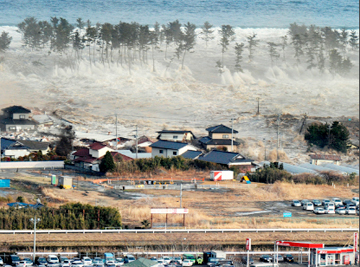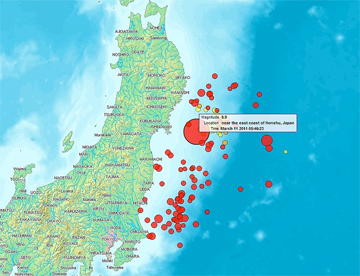Could the earthquake that triggered Japan’s devastating tsunami be linked to climate change?
The short answer is probably not, but recent research suggests that changing climate has the potential to influence earthquakes in some parts of the world
Scientists have shown that weight shifts caused by melting glaciers can trigger tectonic activity. As ice melts and waters runs off, tremendous amounts of weight are lifted off Earth’s crust. As the newly freed crust settles back to its original, pre-glacier shape, it can cause seismic plates to slip and stimulate volcanic activity, according to research into prehistoric earthquakes and volcanic activity.
 Approaching tsunami in Japan. Photo courtesy of Reuters.  Map of the Senadai Earthquake 2011 |
Analyzing an 800,000-year record of volcanic activity in eastern California, Allen Glazner, a University of North Carolina-Chapel Hill geoscientist, found evidence that “peaks of volcanic activity occurred when ice was retreating globally,” as told to the Wall Street Jorunal’s Sharon Begley in 2006. “At first I thought it was crazy, but other scientists also found evidence that climate affects volcanism.”
With Earth’s glaciers and ice gaps melting at increasing rates due to climate change, it is conceivable that we could see further impact from “isostatic rebound” in the Earth’s crust. Work by Patrick Wu, a professor of geophysics of the University of Calgary, suggests that past disappearance of ice “may still be contributing to quakes in eastern Canada.”
“The pressure of the ice sheet suppresses earthquakes, so removing that load triggers them,” Wu told Begley. “Present-day earthquakes may have their origin in postglacial rebound.”
Bill McGuire, professor of Geophysical Hazards at University College, spelled out the scenario further in a 2006 article in New Scientist, titled “Climate change: Tearing the Earth apart?”
“It shouldn’t come as a surprise that the loading and unloading of the Earth’s crust by ice or water can trigger seismic and volcanic activity and even landslides. Dumping the weight of a kilometer-thick ice sheet onto a continent or removing a deep column of water from the ocean floor will inevitably affect the stresses and strains on the underlying rock,” he wrote. “[While] not every volcanic eruption and earthquake in the years to come will have a climate-change link… [As] the century progresses we should not be surprised by more geological disasters as a direct and indirect result of dramatic changes to our environment.”
Japan’s quake
Japan lies in one of the world’s most seismically active areas between four major continental and oceanic plates: the Pacific Plate, Philippine Plate, Eurasian Plate and North American Plate. The country accounts for roughly 20 percent of the world’s earthquakes of magnitude 6 or bigger. It has also suffered from more than 200 tsunamis (tsunami is a Japanese word).
Nevertheless the March 11, 2011 quake had a devastating impact. The 8.9-magnitude earthquake was centered 130 kilometers (81 mi) east of Sendai, Honshu, Japan, or 373 kilometers (232 mi) from Tokyo, according to the United States Geological Survey. It generated a tsunami that caused waves of up to 10 meters to swamp coastal areas of eastern Japan. Thousands were feared dead in the immediate aftermath of the quake and tsunami.
The earthquake was the strongest on record for Japan and one of the world’s five most powerful earthquakes since modern seismological record-keeping began.
Related articles
Did Haiti’s deforestation, hurricane trigger deadly earthquake?
(01/04/2011) Erosion caused by hurricanes and large-scale deforestation may have contributed to last year’s devastating earthquake that killed more than 200,000 people in Haiti, according to a geologist at the University of Miami.
Earthquake triggers decline in a frog species
(12/03/2007) In 1999 a 7.3 earthquake struck Nantou County at the center of quake-prone Taiwan. The earthquake caused considerable damage: over 2,000 people died and just under 45,000 houses were destroyed. It was Taiwan’s strongest quake in a hundred years. The quake also devastated a subpopulation of riparian frogs, Rana swinhoana, which had been under scientific study for three years prior. This devastation allowed scientists the opportunity to study the population changes in a species affected suddenly and irretrievably by natural disaster.
Could a hurricane hit California?
(08/20/2007) San Diego has been hit by hurricanes in the past and could be affected by such storms in the future according to data from the National Oceanic and Atmospheric Administration (NOAA). While a hurricane in San Diego would likely produce significantly less damage than Hurricane Katrina in New Orleans, it could still exact a high cost to Southern California especially if the region was caught off guard.
China uses snake-based earthquake prediction system
(12/27/2006) A province in southern China has come up with a unique way to predict earthquakes: snakes. According to China Daily and as reported by Reuters, the earthquake bureau in Nanning, capital of the Guangxi province, has set up a 24-hour video feed to monitor the behavior of snakes at snake farms. The scientists say that snakes are particularly sensitive to vibrations caused by impending earthquakes.